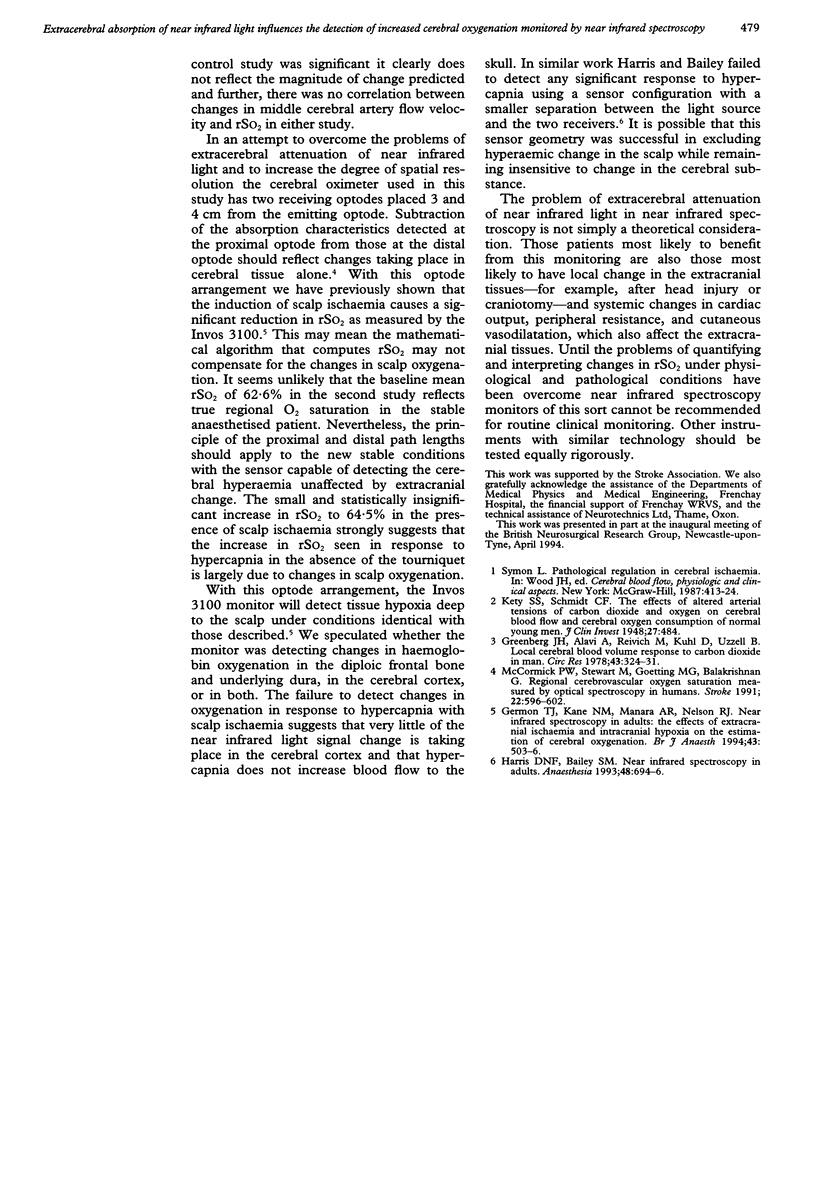Abstract
The detection of increased cerebral oxygenation secondary to cerebral hyperaemia, induced by hypercapnia has been studied in anaesthetised patients using a near infrared, reflectance mode, cerebral oxygenation monitor (Invos 3100 Somanetics, Troy, Michigan, USA). Two studies were performed, with and without a pneumatic scalp tourniquet, to distinguish between extracranial and intracranial changes in tissue oxygenation. In the control study a mean increase in end tidal CO2 of 23.1 mm Hg was accompanied by a mean increase in middle cerebral artery flow velocity of 116%. Regional cerebral oxygen saturation (rSO2) measured transcutaneously in the frontal distribution of the middle cerebral artery increased significantly from 70.5% to 74.6% (p = 0.001). During the second study with a scalp tourniquet inflated to maintain the extracranial tissues in a state of stable ischaemia a mean increase in end tidal CO2 of 22.3 mm Hg was accompanied by a mean increase in middle cerebral artery flow velocity of 121%. The change in rSO2 from 62.6% to 64.5% was not significant (p = 0.085). There was no correlation between the change in middle cerebral artery flow velocity and rSO2 in the control or scalp ischaemia group. This study shows that the Invos 3100 monitor is sensitive to tissue oxygenation but does not reliably detect changes in cerebral oxygenation as a result of profound cerebral hyperaemia. The contribution of extracerebral tissue to the attenuation of near infrared light and the lack of spatial resolution remain major problems to be overcome before this or other near infrared spectroscopy instruments can be introduced into clinical practice.
Full text
PDF


Selected References
These references are in PubMed. This may not be the complete list of references from this article.
- Germon T. J., Kane N. M., Manara A. R., Nelson R. J. Near-infrared spectroscopy in adults: effects of extracranial ischaemia and intracranial hypoxia on estimation of cerebral oxygenation. Br J Anaesth. 1994 Oct;73(4):503–506. doi: 10.1093/bja/73.4.503. [DOI] [PubMed] [Google Scholar]
- Greenberg J. H., Alavi A., Reivich M., Kuhl D., Uzzell B. Local cerebral blood volume response to carbon dioxide in man. Circ Res. 1978 Aug;43(2):324–331. doi: 10.1161/01.res.43.2.324. [DOI] [PubMed] [Google Scholar]
- Harris D. N., Bailey S. M. Near infrared spectroscopy in adults. Does the Invos 3100 really measure intracerebral oxygenation? Anaesthesia. 1993 Aug;48(8):694–696. doi: 10.1111/j.1365-2044.1993.tb07183.x. [DOI] [PubMed] [Google Scholar]
- Kety S. S., Schmidt C. F. THE EFFECTS OF ALTERED ARTERIAL TENSIONS OF CARBON DIOXIDE AND OXYGEN ON CEREBRAL BLOOD FLOW AND CEREBRAL OXYGEN CONSUMPTION OF NORMAL YOUNG MEN. J Clin Invest. 1948 Jul;27(4):484–492. doi: 10.1172/JCI101995. [DOI] [PMC free article] [PubMed] [Google Scholar]
- McCormick P. W., Stewart M., Goetting M. G., Balakrishnan G. Regional cerebrovascular oxygen saturation measured by optical spectroscopy in humans. Stroke. 1991 May;22(5):596–602. doi: 10.1161/01.str.22.5.596. [DOI] [PubMed] [Google Scholar]


